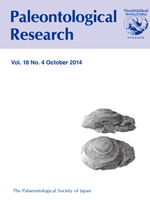The Permian large gastropod “Pleurotomaria” yokoyamai Hayasaka was found for the first time from the Capitanian (upper Guadalupian) Iwaizaki Limestone in the South Kitakami Belt, Northeast Japan. A smaller planispiral gastropod Porcellia sp. was found in association with it. These taxa have been scarcely reported, except from the coeval Permian limestones at Akasaka in Southwest Japan and in the Balya Maden area, western Turkey. The Akasaka Limestone was deposited as a low-latitude atoll on a mid-Panthalassan seamount, whereas the Iwaizaki Limestone was laid down as a patch reef within a terrigenous clastics-dominated facies on a shallow marine continental shelf. The occurrence of this unique assemblage suggests that the Iwaizaki Limestone originated also in a Permian low-latitude domain, and that the South Kitakami Belt likely formed a part of the continental margin of South China, representing its eastern extension to Northeast Japan.
How to translate text using browser tools
1 October 2014
The Occurrence of the Large Gastropod “Pleurotomaria” Yokoyamai Hayasaka from the Capitanian (Permian) Iwaizaki Limestone in Northeast Japan
Yukio Isozaki,
Tomoki Kase
ACCESS THE FULL ARTICLE

Paleontological Research
Vol. 18 • No. 4
October 2014
Vol. 18 • No. 4
October 2014
Capitanian
gastropod
Permian
South China
South Kitakami Belt




